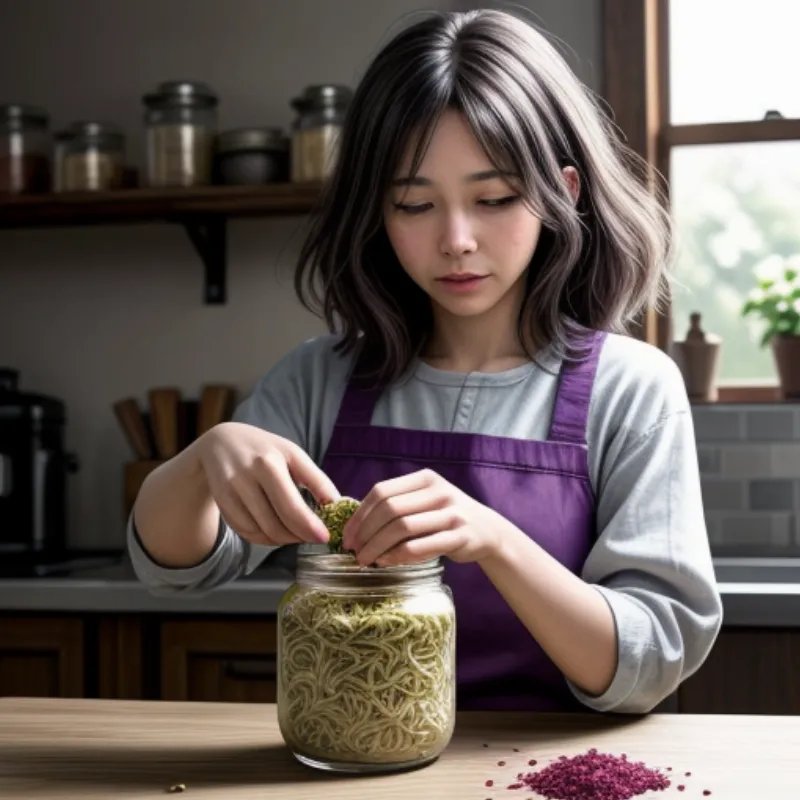Pickled cabbage, also known as sauerkraut, is a fermented food that has been enjoyed for centuries. Its tangy, slightly sour flavor adds a delicious crunch to sandwiches, salads, and even enjoyed as a side dish. The best part? Making your own pickled cabbage at home is incredibly easy and rewarding.
Imagine the satisfaction of transforming simple cabbage into a vibrant, flavorful condiment using just a few ingredients and a bit of patience. This guide will walk you through every step, from choosing the right cabbage to achieving that perfect tangy crunch. Let’s get pickling!
Gathering Your Ingredients and Tools
Before we begin our pickling journey, let’s gather everything we need:
Ingredients
- Cabbage: You’ll need about 1 medium head of green cabbage (approximately 2 pounds). Look for a firm head with crisp, tightly packed leaves.
- Salt: Use non-iodized salt, about 1-2 tablespoons. The salt plays a crucial role in the fermentation process, so using the right kind is essential.
- Optional Flavor Enhancers: Get creative and add extra flavor dimensions with ingredients like:
- Caraway seeds: A classic pairing with pickled cabbage, adding a slightly sweet and earthy flavor.
- Juniper berries: These berries lend a subtle piney aroma and a hint of citrus.
- Mustard seeds: For a touch of warmth and complexity.
- Garlic cloves: Use peeled and lightly crushed cloves for a pungent kick.
- Red pepper flakes: Add a touch of heat if you like a bit of spice.
Equipment
- Large bowl: For mixing the cabbage and salt.
- Sharp knife: For shredding the cabbage.
- Cutting board: A sturdy board to protect your countertop while you chop.
- Jar or crock: Choose a clean glass jar or a traditional fermentation crock to store your pickled cabbage during the fermentation process.
- Weight: You’ll need something to keep the cabbage submerged in its brine. This can be a smaller jar filled with water, a fermentation weight, or even a clean plate that fits inside your jar.
 Pickled Cabbage Ingredients
Pickled Cabbage Ingredients
Step-by-Step Guide to Pickled Cabbage Perfection
Now that you have your ingredients and tools ready, let’s dive into the pickling process:
1. Preparing the Cabbage
- Rinse: Thoroughly rinse the cabbage under cool running water and pat it dry.
- Remove the core: Cut the cabbage in half and remove the tough core.
- Shredding: Use a sharp knife or a mandoline slicer to thinly shred the cabbage. Aim for shreds about 1/8 inch thick.
2. Salting and Massaging the Cabbage
- Combine cabbage and salt: Place the shredded cabbage in the large bowl and sprinkle it evenly with the salt.
- Massage the cabbage: Using clean hands, massage the cabbage for about 5-10 minutes. You’ll notice the cabbage will start to soften and release liquid. This liquid, along with the salt, forms the brine that’s crucial for fermentation.
3. Packing the Jar
- Add to your jar: Pack the cabbage tightly into your clean jar or crock, pressing down firmly to eliminate air pockets. As you pack the jar, add any optional flavor enhancers you’re using, distributing them evenly throughout the cabbage.
- Submerge the cabbage: Pour the liquid released from the cabbage into the jar. The cabbage needs to be completely submerged in the brine to prevent mold growth. If there isn’t enough liquid, you can make a simple brine by dissolving 1 teaspoon of salt in 1 cup of water and adding it to the jar.
- Weigh it down: Place your weight on top of the cabbage to keep it submerged beneath the brine.
4. Fermenting Your Pickled Cabbage
- Cover the jar: Loosely cover the jar with a clean cloth or lid. Don’t seal the jar airtight, as this can cause pressure to build up during fermentation.
- Fermentation time: Find a cool, dark place to store your jar for 3-10 days. The ideal temperature for fermentation is around 65-75°F (18-24°C).
- Taste test: After 3 days, start tasting your pickled cabbage. You’ll notice the flavor becoming tangier as it ferments. Once it reaches your desired level of sourness, it’s ready!
 Woman Making Pickled Cabbage
Woman Making Pickled Cabbage
Tips and Tricks for Pickled Cabbage Success
- Salt matters: Using the right type and amount of salt is essential for both flavor and safe fermentation. Iodized salt can hinder the fermentation process, so stick with non-iodized.
- Cleanliness is key: Thoroughly wash your hands, jars, and utensils before you begin to prevent unwanted bacteria from interfering with the fermentation.
- Temperature control: Temperature plays a significant role in how quickly your cabbage ferments and develops flavor. Warmer temperatures will speed up the process, while cooler temperatures will slow it down.
Serving and Enjoying Your Pickled Cabbage
Your homemade pickled cabbage is incredibly versatile and can be enjoyed in countless ways! Here are a few ideas:
- As a condiment: Add a generous spoonful to sandwiches, hot dogs, or burgers for a tangy crunch.
- In salads: Its vibrant flavor and crunchy texture add a refreshing twist to salads of all kinds.
- Side dish: Serve it alongside grilled meats, roasted vegetables, or hearty stews for a flavorful counterpoint.
Pickled cabbage is not only delicious but also incredibly good for you. “The fermentation process creates probiotics, which are beneficial bacteria that can improve digestion and boost your immune system,” explains renowned fermentation expert, Sarah Jones.
 Pickled Cabbage Serving Suggestion
Pickled Cabbage Serving Suggestion
Making your own pickled cabbage is a simple and rewarding way to enjoy this tangy and flavorful condiment. Plus, it’s a great way to add beneficial probiotics to your diet. Why not give this easy recipe a try? Share your experiences, variations, and culinary creations with us in the comments below.
For more pickling and fermenting adventures, explore our other recipes on Family Cuisine, like how to make pickled red cabbage or how to make pickled vegetable slaw!
